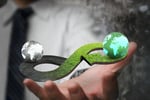What’s Growth got to do with it…as it happens plenty, and Indian Infrastructure is a key driver for Housing Policy
Keynes wondered about kick starting an economy, paying people to bury bottles with £10 notes in them, and then paying others to dig them up and spend the cash. Of course, the great man’s tongue was probably firmly in his cheek, but he was making a serious point: modern economies are driven by expansionary policies. That’s what lies at the heart of quantitive easing strategies. But it’s much better to spend those £10 notes on roads that don’t go nowhere, which is why infrastructure policy is so important. And there’s no better example of that at the moment than India, which has seen unprecedented infrastructure spending over the last decade and COVID has done little to slow it down.
This month alone Indian Railways launched 22 new local and 18 main line services in Mumbai (on 10 October); on 12 October the 11 km rail tunnel connecting Howrah to Salt Lake (via Kolkata) was completed (part of a 17 km system including 6km of elevated sections), and the Union Ministry of Road Transport announced 2,921 km of new highways had been completed as part of the Bharatmala Pariyojana Project. All of which are having a knock on effect on expansion across key areas of the Indian economy, including housing and construction, which are growing like never before. Those roads certainly aren’t going nowhere…
Since 24 September The BSE Sensex Index (which tracks stock on the Bombay Exchange), has rallied by nearly 11%: its strongest performance since June, the best of any equity benchmark anywhere in the world. And it’s now within 2% of wiping out its entire losses for the year to date: given the economic shocks of COVID 19, that’s no mean feat.
Sameer Kaira (of influential, Mumbai based Target Investing) has predicted a third quarter bounce in GDP on the subcontinent, with Sensex likely to hit a record high by December. With a Delphic sense of understatement, Kaira highlighted a key factor as “various steps taken by policy makers”. But what does he mean by that?
Well, for a start Prime Minister Modi’s Government is set to relax COVID restrictions further, allowing schools and entertainment complexes to re-open from October 15, and also loosen restrictions on large gatherings: so that’s certainly one important step from a policy maker. But more expansive policymaking hasn’t gone away either. The Reserve Bank’s Monetary Policy Committee has announced further steps to increase liquidity: leaving the repo rate (the rate at which it lends to other banks) unchanged at 4% and promising to maintain its “accommodation stance” well into the next fiscal year. The Governor of the Bank also announced another round of quantitative easing as part of its Operation Twist initiative, much to the delight of financial markets and external investors (10 year Bond yields fell to 5.9%).
All of which is fuelling the infrastructure boom.
And because all those roads, trains and tunnels aren’t going nowhere, its also giving added impetus to India’s Real Estate Markets: primed to meet the needs of the fastest growing population on the planet and spurred on by the Government’s Affordable Housing Programme. Better infrastructure suddenly makes building projects across the country a much more attractive proposition.
It’s certainly better than burying cash in a bottle…
Modulex Construction is the World’s largest Steel Modular Building Company. It was established by Red Ribbon to harness the full potential of fast evolving technologies and deliver at pace to meet the subcontinent’s evolving needs.
Modulex is setting up the world’s largest steel modular buildings factory based in India. It was established by Red Ribbon to harness the full potential of fast-evolving technologies and deliver at pace to meet the evolving needs of the community.
Modulex is setting up the world’s largest steel modular buildings factory in India.
Executive Overview
With a further easing of lockdowns underway, the subcontinent’s financial markets are starting to move forward: faster than other equity markets across the world. And that has a lot to do with the Central Bank’s Operation Twist Programme, which is fuelling growth across the country.
No surprise then that the impact of these emerging trends will be first felt in Infrastructure policy, something I’m sure will act as a key driver for the rest of the economy.







Leave a Reply